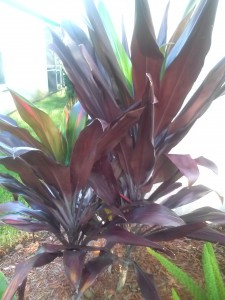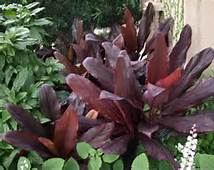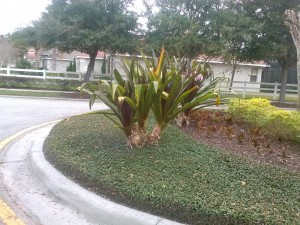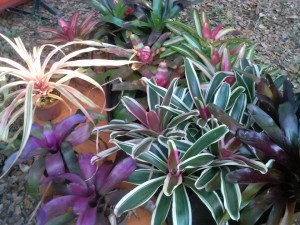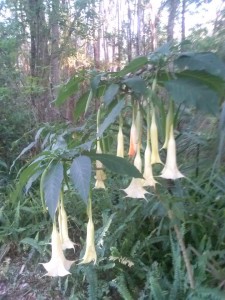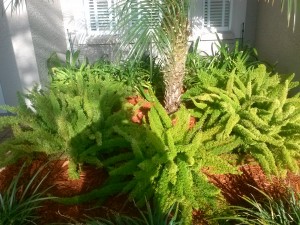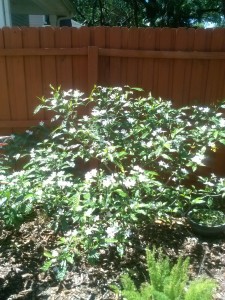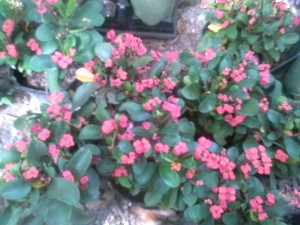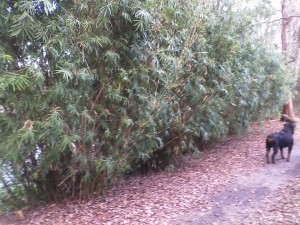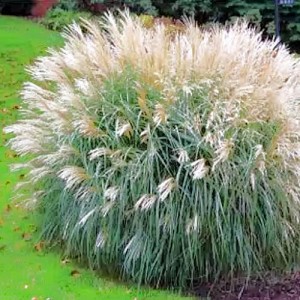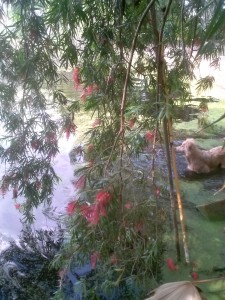Every landscaper and gardener has their favorite go-to landscape plants, that they prefer to include in a landscape design for their unique color or foliage, ease in maintenance, and versatility under many planting conditions. Here are my favorite landscape plants, my top 10 (although I will admit, it was hard to winnow the list to only 10!)
Ti Plants, but only certain varieties. I like to use the varieties that can be planted in full sun or shade, and stay full throughout the plant, naturally or with a little trimming. My two favorites are Black Magic (on the left) for areas that could use a larger and wider growing plant, or varieties such as Auntie Lou or Xerox (on the right), that are more slender, upright growers. And, I never, never use Red Sister! In fact, Red Sister usually looks horrible after the first year, and, sadly, just gives the rest of the family a bad reputation.
Crinum Lily, either green leaf or the red-leafed varieties. This is a great 4'X4' growing plant, your mid-sized mini-specimen, so that not everything is tall or small in the landscape design. It is drought tolerant, generally pest free, and needs two time a year leaf clean up. Occasionally, small pups do need to be removed, but they can either be planted elsewhere in the garden, or given to friends in a seed or cutting exchange.
Blushing Bromeliads, the Neo variety (not the ones that are green all year and bloom once a year for a month). These wonderful plants come in all leaf colors and growth sizes, and if used properly, can add foliage interest to a well-designed landscape. They have little maintenance requirements, and multiply over time to fill in an bed area, and yet are still easy care enough that you can control their growth so that they do not over take your garden.
Angel's Trumpet is not for everyone, but if you have the room and the inclination, this plant can provide endless ghostly salmon or white trumpet flowers during the humid summer months, that have a delicious subtle fragrance that wafts through the stillness of the night air. It is a hallucinogen, though, so care must be taken with pets and children.
Foxtail Fern could not be a more versatile plant, that lives in almost all light and soil conditions. It's bright lime, funky foliage works well against almost any other plant color and texture, and can be used as a border plant, or a mid-sized filler plant. As well, it is unique in that it's foliage generally does not "stretch" or change color in the sun versus shade, so it can easily be used as a plant that matches on both sides of a bed with different light conditions.
Pinwheel Jasmine is a mid-sized shrub that blooms almost year-around, in sun or shade. It makes a great background or foundation plant, and it's blooms stand out nicely in the shade or even at night. White foliaged or white blooming plants are often over-looked in the landscape, but they stand out nicely against dark paint colors or other green-foliage plants, and can help other bold landscape colors pop.
Dwarf Crown of Thorn is a fabulous option to use instead of seasonal flowers. Seasonal flowers must be changed out 2-4 times a year, whereas Dwarf Crown of Thorn is a long living perennial that blooms throughout the year. If trimmed properly (two times a year), it can grow to the size of a soccer ball, and will be dense throughout the plant. While it can be prone to frost and freeze damage, it generally bounces back within one season, making it a viable landscape plant for a Tampa garden.
Dwarf Bamboo varieties such as Alphonse Karr, Golden Goddess, or Fernleaf cannot be matched as far as privacy barriers go. They are not only quick growing, they are cold hardy for Tampa landscapes, drought tolerant, and pest free. They require little maintenance after they are established, and have foliage from top to bottom, making them ideal for privacy. Dwarf Bamboo does require space to grow though, as they can grow almost as wide as they grow tall (8'-15'), so that must be taken into consideration. Despite that, they also offer an easy tropical or lush flair to many styles of landscape design.
Adagio Grass, also called Chinese Silver Grass, is a large growing (4'X4') landscape grass that is a great substitute for the much larger growing Pampas Grass. In the landscape, it can be used as a stand alone feature, as a background plant, or in mass plantings. It provides many soft white plumes throughout most of the warm months, and it's foliage has a white rib, that gives it a silver shimmer. I find that it grows well in most soil conditions, and while it prefers full sun, it will tolerate and still bloom in part shade. While it can hold on to it's old leaves as it grows new ones, one easy method to remove these is to use a leaf rake like a hair comb, used upside down. Other than this 1-2 time a year maintenance task, this plant is generally care-free.
Bottlebrush is a small growing tree that can easily be sheered and trimmed to a desired size, thereby making it a perfect candidate for a small specimen plant or privacy barrier. It can also be allowed to grow to it's full potential of 15-20', allowing it to be a magnificent and glorious centerpiece of your landscape design. It can be purchased in multi-trunk form or in single trunk form (called a standard), and I generally prefer the standard variety, as it allows for plantings underneath to help create a multi-layered landscape design. Bottlebrush trees can bloom for several months of the year, and have the added bonus of being pollinators that attract butterflies, honey bees, and hummingbirds. Preferably, they should be lightly trimmed once a year to help keep them dense.
From these photos, and my brief plant descriptions, you may be able to see why I have listed these as my favorite landscape plants, and as my top 10. I have many more favorites, and I will post about them later, perhaps as another round of favorite landscape plants, top 20. Mostly, though, they made the list for their ease in care, fabulous characteristics of form/color/texture interest in a landscape design, and their versatility of site conditions and purposeful use in the landscape.
When you decide as to what you would like in your landscape, I suggest that you start with a favorite list as well, and then learn the nature of that plant to determine if it will fit into your over-all plans. Again, half the joy of gardening is the trial and error.
So, let's get to picking favorites and making new garden friends, folks!
Donell

